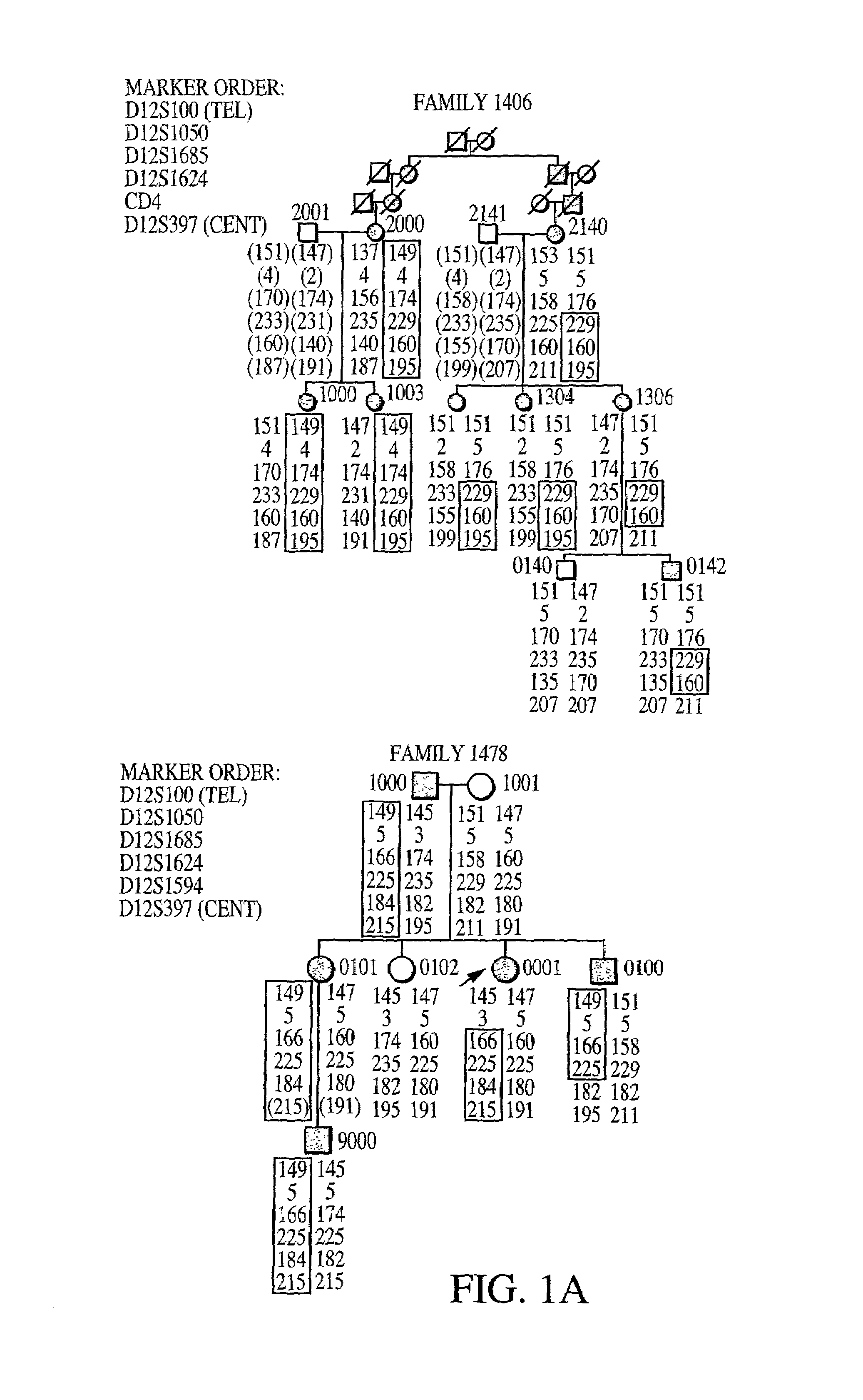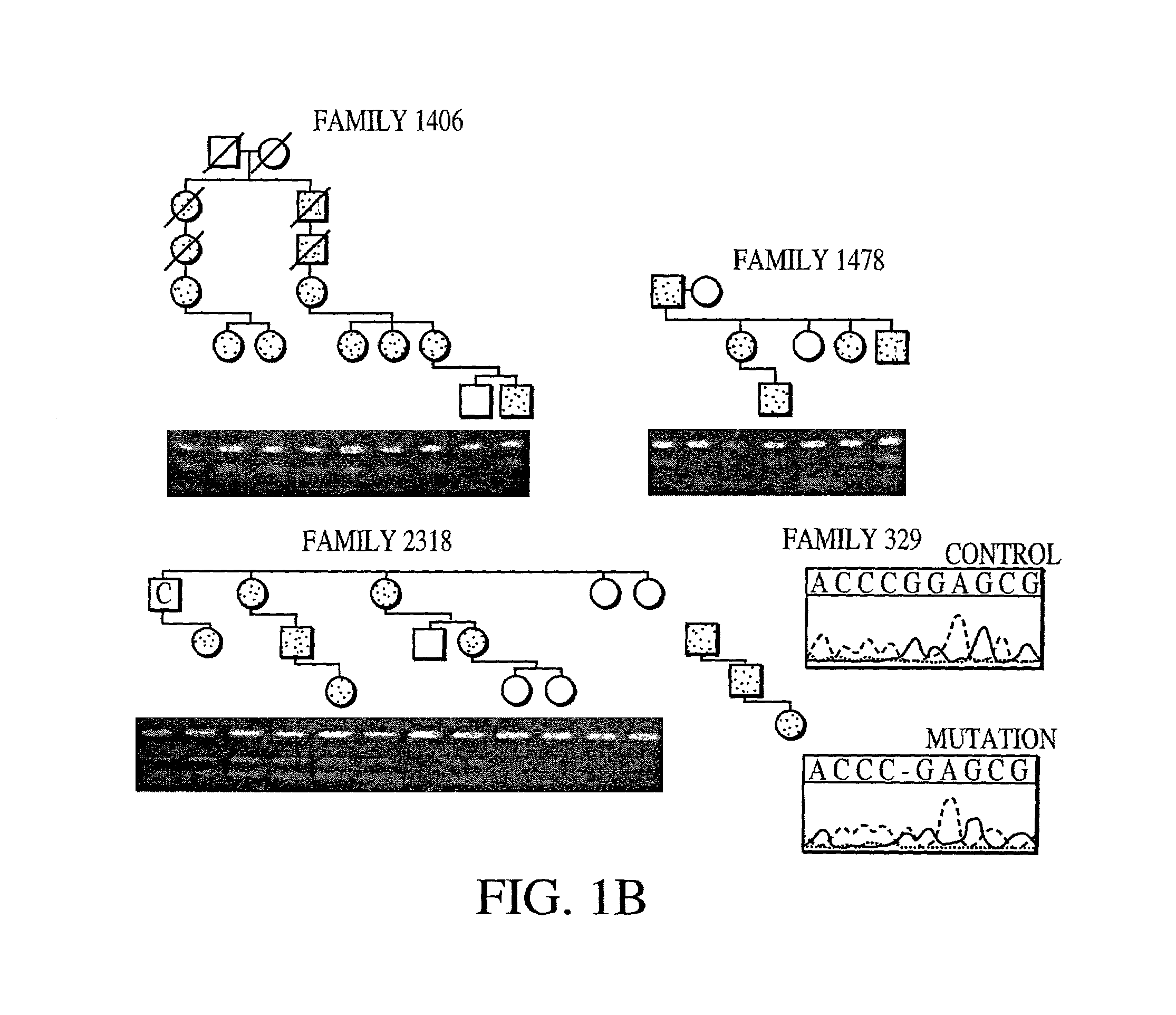Fibroblast growth factor (FGF23) nucleic acids
- Summary
- Abstract
- Description
- Claims
- Application Information
AI Technical Summary
Benefits of technology
Problems solved by technology
Method used
Image
Examples
example 1
Linkage and Mutational Analysis of ADHR Families
[0294]The data herein demonstrate the discovery of a novel gene, FGF23. Also demonstrated below is the discovery that ADHR maps to the short arm of chromosome 12 into 12p13.3, FGF23 maps into this region, and FGF23 is mutated in individuals suffering from ADHR.
[0295]The materials and methods used in the experiments presented in this example are now described.
Pedigree Analysis
[0296]Pedigrees of families of British (family 2318), German (family 329), and American (families 1406 and 1478) origin were analyzed. The ADHR+families 1406, 1478 and 2318 have been described previously (Econs, et al. 1992, J. Clin. Endocrinol. Metab. 82:674–681; Bainchine, et al. 1971, Birth Defects Orig. Aric. Ser. 7:287–295; Rowe, et al. 1992, Hum. Genet. 89:539–542). The study was approved by the Indiana University School of Medicine and the Ludwig-Maximilians-Universitäit Faculty of Medicine Institutional Review Boards, and all patients gave informed consent ...
example 2
Expression of FGF23
[0307]The data herein demonstrate expression of FGF23 in human tissues and cancer cell lines. Also demonstrated in this example is generation of an antibody specific for FGF23 and its use to detect FGF23 produced in bacterial and mammalian cells. The data presented in this example further demonstrate that FGF23 is a secreted protein and that FGF23 is expressed abundantly in oncogenic hypophosphatemic osteomalacia (OHO) tumors.
[0308]The materials and methods used in the experiments presented in this example are now described.
Northern Blot Analysis.
[0309]Multiple tissue Northern blots containing 2 μg polyA+-RNA from each tissue (ClonTech Inc. Palo Alto, Calif.) were incubated with full length FGF23 (FIG. 5A or 6A) probe in hybridization buffer (270 mM NaCl, 15 mM Na2HPO4, 15 mM EDTA, 1% SDS, 10% Dextran sulfate 0.5% skimmed milk powder) at 65° C. with washing in 0.01×SSC at 60° C.
Bacterial Production of FGF23.
[0310]A human FGF23 cDNA was produced by PCR amplificati...
example 3
The Effects of ADHR Mutations on FGF23 Protein Cleavage and Heparin Binding
[0322]The data herein demonstrate that FGF23 mutations that are linked to ADHR results in increased levels of the larger protein species of FGF23, due to an inability of proteases to efficiently cleave FGF23 at a consensus SPC site. Also demonstrated in this example is the ability of mutant forms of FGF23 to bind heparin at levels comparable to wild-type FGF23.
[0323]The materials and methods used in the experiments presented in this example are now described.
Mutagenesis of FGF23.
[0324]The ADHR missense mutations, R176Q, R179W, R179Q, were introduced into the FGF23 cDNA using a nested PCR, site-directed mutagenesis approach. The high-fidelity DNA polymerase Pfu (Promega, Inc., Madison, Wis.) was used in all PCR reactions using pFGF23 (pcDNA3.1 backbone) as a template. For the initial round of PCR, each forward mutagenic primer containing the appropriate missense was paired with the reverse 3′FGF23 primer and e...
PUM
| Property | Measurement | Unit |
|---|---|---|
| Fraction | aaaaa | aaaaa |
| Fraction | aaaaa | aaaaa |
Abstract
Description
Claims
Application Information
 Login to View More
Login to View More - R&D
- Intellectual Property
- Life Sciences
- Materials
- Tech Scout
- Unparalleled Data Quality
- Higher Quality Content
- 60% Fewer Hallucinations
Browse by: Latest US Patents, China's latest patents, Technical Efficacy Thesaurus, Application Domain, Technology Topic, Popular Technical Reports.
© 2025 PatSnap. All rights reserved.Legal|Privacy policy|Modern Slavery Act Transparency Statement|Sitemap|About US| Contact US: help@patsnap.com



